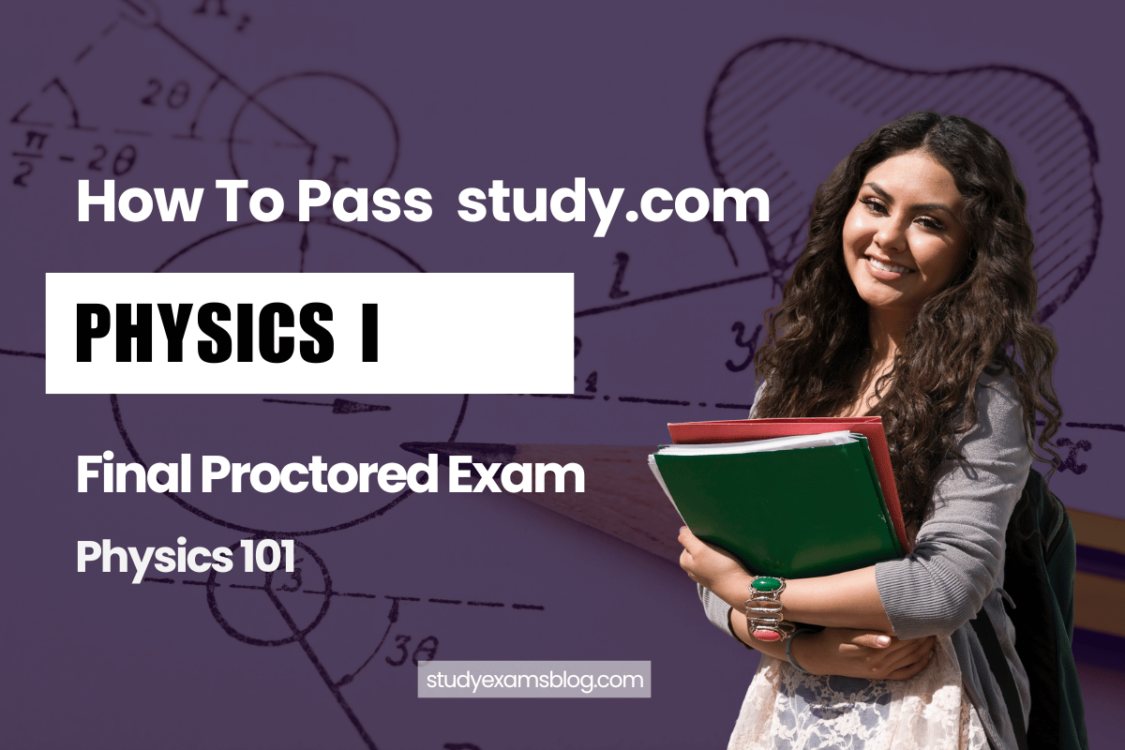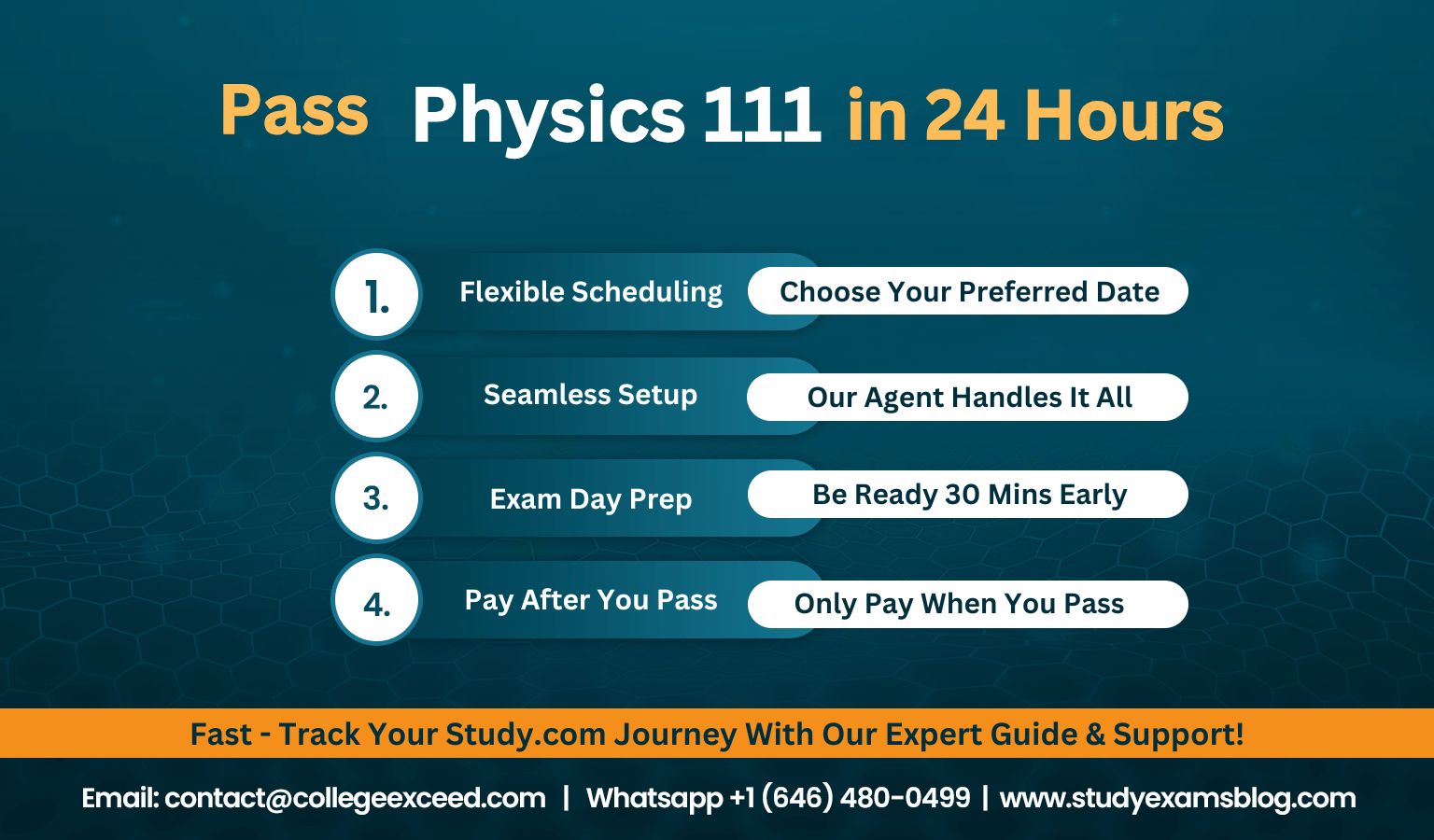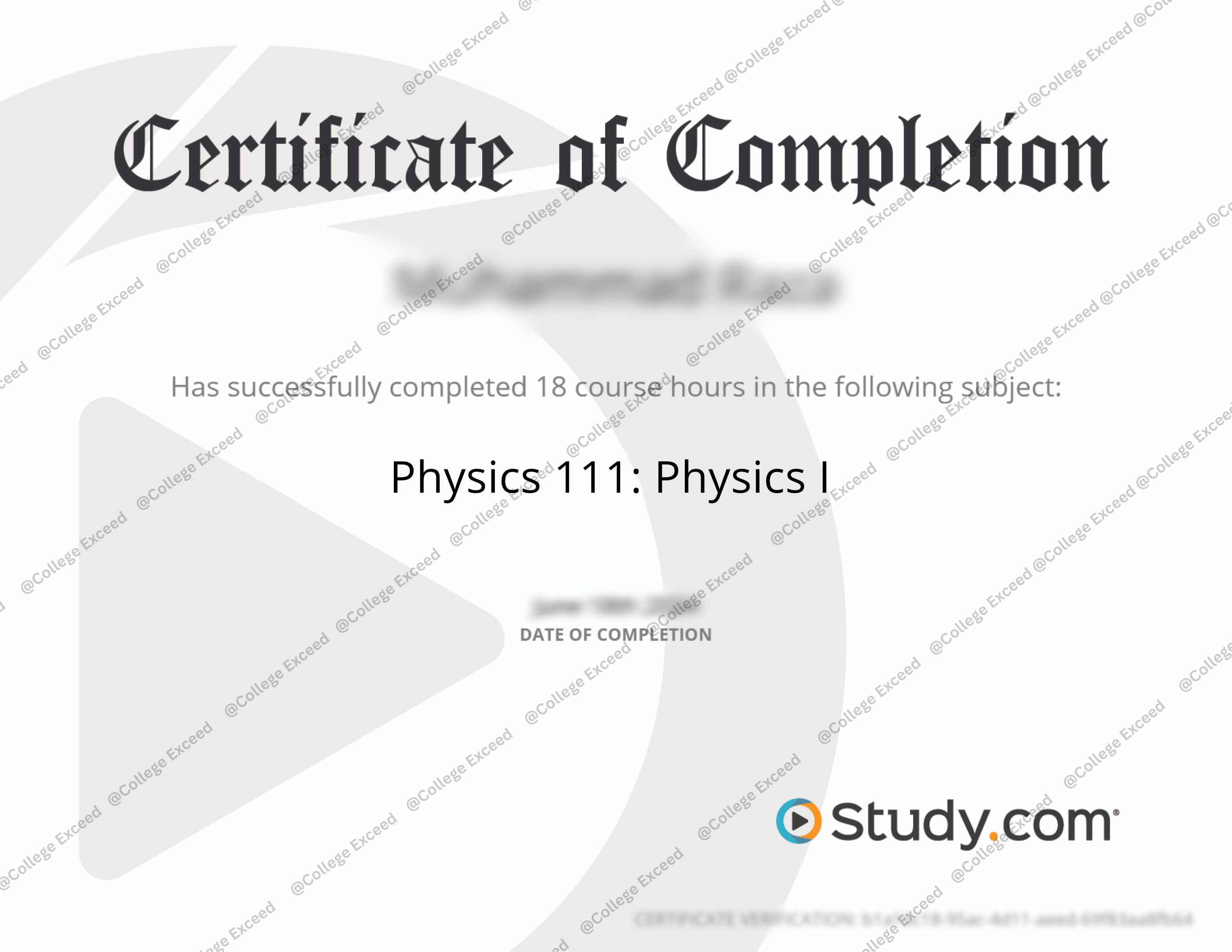
-
Gavin Walton
- November 6, 2024
Greetings to all as you join the course Physics I course offered at study.com! If you ever asked yourself how things work today starting from why falling objects fall to waves and energy conservation then this is the course for you. You should consider it as your private guided tour of the set of axioms that define our physical world. , from the great subject of understanding forces inherent to nature up to the mystical topic of oscillations and waves, Study. Physics 111: Physics I of com will guide you from atoms to atoms to the foundations of college physics.
But do not worry, this is not the conventional, boring class in science as a subject matter. It will help to make knowledge more digestible rather than using torrents of information that will overwhelm you. And the best part? Almost all that you learn in this class has the aspect of reality and reality as we find it in our daily lives. Whatever your reason for wanting to successfully go through that day’s lesson or next exam, you’ll find in this guide the tools that will enable you to go through the course with a smile on your face if all goes well!
---

What to Expect from Physics 111 Class📖
Study.com Physics 111: Physics I deals with the main concepts that define what physics is all about so prepare to go directly into the crux of the matter or rather the universe! The subjects that you are going to cover in your class include motion and force, energy and momentum, and even light. The course is guided from one concept to the other in physics with an emphasis on ensuring that you grasp the fundamental concepts that will be assessed in your exam.
First, you will review the fundamentals of kinematics where you will learn about displacement, velocity, and acceleration. These concepts are important to understand the motion of objects and, yes, prepare yourself for some graph interpretations and formulas; do not worry though, we will be right there with you. After this, you will proceed to Newton’s Laws of Motion, which are some of the fundamental principles in physics that tackle the forces that make objects either continue or remain still. As I have indicated, these laws are going to be scattered throughout the exam so make sure you are familiar with all of them!
Further on in the course, you will analyze such crucial elements as force of work, energy, and power, which form the core of countless physical problems. Momentum and the rotational motion are also in this level and they are usually causes of concern to many students. But with the right approach and little practice, you will be on the right track In fact, you will be an expert! Finally, towards the end of the class, you will study waves and their types, sound and light, and also look at some fluids and their characteristics which of course are evident in our day-to-day lives for example air pressure or buoyancy of a boat.
Therefore by the time you complete this course, you will understand basic issues of physics and also know how to pass the test and most importantly, how to look at things from a different angle; literally.
Week-by-Week Study Plan to Ace Physics 111 Exam 📝
Let me present you with the week-by-week study schedule. Consistency here is the name of the game and this plan will take you through this course without experiencing too much of a strain. If you follow this timetable, you’ll be in good standing to pass the study.com Physics 111: Physics I examination.
Week 1: Master the Basics (Kinematics & Vectors)
Start by getting comfortable with the basic building blocks of physics: displacement, velocity, and acceleration. Understanding these will make everything else easier. Spend time on vector diagrams and practice breaking vectors into components. Also, make sure you can graph motion over time—it will help visualize movement.
- Key Topics: Displacement, velocity, acceleration, vectors
- Study Resources:
- Khan Academy – Introduction to Vectors and Scalars
- Quizlet Flashcards for Kinematics
Week 2: Dive into Newton’s Laws of Motion
Focus on Newton’s Laws—these will be heavily tested. Practice free-body diagrams and understand the difference between balanced and unbalanced forces. This week, also start solving simple problems involving Newton’s second law (F=ma).
- Key Topics: Newton’s First, Second, and Third Laws, free-body diagrams, force, mass, and acceleration
- Study Resources:
- YouTube – Newton’s Laws of Motion
- Physics Classroom – Free Body Diagrams
Week 3: Work, Energy & Power
Time to understand the relationship between work, energy, and power. Get familiar with the work-energy theorem and practice problems on potential and kinetic energy. Focus on understanding the conservation of energy—this concept is crucial for many exam questions.
- Key Topics: Work-energy theorem, kinetic energy, potential energy, power
- Study Resources:
- Khan Academy – Work and Energy
- Quizlet – Energy Formulas
Week 4: Momentum & Rotational Motion
Change is not easy, especially when it is fueled by momentum, therefore one should be cautious and take it easy. Learn about: Linear momentum; Impulse; and Collisions both elastic and inelastic. Then, let’s switch to the rotation and discuss the torque—a topic that is more connected with the concepts of force and motion already considered.
- Key Topics: Linear momentum, collisions, rotational motion, torque
- Study Resources:
- YouTube – Momentum & Impulse
- Quizlet – Momentum Flashcards
Week 5: Waves & Sound
This week everyone in the class can study waves and sound. Start learning about such facts concerning waves as amplitude, frequency, and wavelength. Review the characteristics of transverse and longitudinal waves and build up the ability to distinguish the examples of these two types of waves. In addition, find out about the Doppler effect – this is applied in tests quite often On this page, you will find brief descriptions of basic physics concepts and links to articles about them. .
- Key Topics: Waves, sound, Doppler effect
- Study Resources:
- YouTube – Sound Waves
- Quizlet – Waves Flashcards
Week 6: Light & Electromagnetic Spectrum
Discover the domain of light and Electromagnetic spectrum. Here you will find out the particle-like nature and wave-like nature of the light. Concerns should be on concepts like refraction, diffraction, and the photoelectric effect.
- Key Topics: Electromagnetic spectrum, light, refraction, diffraction
- Study Resources:
- Khan Academy – Electromagnetic Spectrum
- Quizlet – Light Physics Flashcards
Week 7: Fluids & Pressure
Now it is high time to consider some fluids and their properties, namely pressure, buoyancy, and such fundamental principles as Pascal’s principle. Discover how pressure varies with depth and how fluids respond under different situations. This week also relates to force topics discussed in previous weeks.
- Key Topics: Pressure, buoyancy, Pascal’s principle
- Study Resources:
Week 8: Review & Practice Exam Questions
Use this week to review all topics and do as many practice problems as you can. Practice past exam questions and focus on areas where you feel less confident. This week is also great for reviewing flashcards and refreshing your memory on key formulas.
- Study Resources:
- Quizlet – Physics 111 Flashcards
- Khan Academy – Practice Physics Problems
This week-by-week plan will keep you on track and make sure you’re fully prepared by the time the exam rolls around! Keep going, and don’t hesitate to revisit challenging topics with extra study resources.
---
Free External Resources to Study📂
To make sure you fully grasp all the challenging concepts in Study.com Physics 111: Physics I, here’s a list of free, reliable resources that will help you dive deeper. Since you’re already subscribed to Study.com, these external resources are all free and will complement the lessons and help with areas where you need extra practice or different explanations.
- Khan Academy
- Why it’s helpful: Khan Academy offers in-depth explanations and tutorials on virtually every physics topic covered in this course. The videos break down complex ideas into bite-sized chunks, making it easier to follow along.
- Best for: Topics like vectors, kinematics, Newton’s Laws, and rotational motion.
- Link: Khan Academy Physics
- Physics Classroom
- Why it’s helpful: This website offers detailed, student-friendly tutorials and practice problems. It’s great for visual learners with interactive simulations and animations.
- Best for: Free-body diagrams, work-energy theorem, momentum, and Newton’s laws.
- Link: Physics Classroom
- YouTube – DrPhysicsA
- Why it’s helpful: DrPhysicsA explains physics concepts step-by-step using whiteboard illustrations, making them easier to visualize.
- Best for: Electromagnetic waves, light, sound waves, and simple harmonic motion.
- Link: DrPhysicsA YouTube Channel
- HyperPhysics
- Why it’s helpful: HyperPhysics is an elaborate source of physics concepts, which are explained effectively with diagrams and brief descriptions. It works great to revisit and/or gain different views on a subject.
- Best for: Waves, oscillations, and optics.
- Link: HyperPhysics
- Quizlet Flashcards
- Why it’s helpful: Quizlet offers a huge range of flashcards for physics topics that are perfect for quick reviews and memorizing formulas.
- Best for: Memorizing formulas, concepts, and definitions.
- Link: Quizlet Physics Flashcards
- Flipping Physics (YouTube Channel)
- Why it’s helpful: Flipping Physics offers fun and engaging videos that bring physics to life. The quirky presentation style makes difficult topics more approachable.
- Best for: Newton’s Laws, momentum, work, and energy.
- Link: Flipping Physics YouTube Channel
These external resources will give you extra practice, alternative explanations, and visual learning aids to ensure you fully understand all the key concepts for Physics 111: Physics I. Plus, they’re all free—so feel free to explore!
---
Key Topics to Focus On🔑
This section will explain some of the most important ideas of the given topic discussed in Study.com Physics 111: Physics I to ensure that you have grasped the important areas to cover. It is going to be quite a complicated mathematical analysis and so we are going to make use of comparisons, tabulation, and real-world examples to explain these concepts. Without further ado, allow me to introduce you to four top concepts that you have to familiarize yourself with!
- Velocity vs. Acceleration
People tend to mix up these two since the word ‘motion’ is used in them, but they are in fact different.
Aspect | Velocity | Acceleration |
|---|---|---|
Definition | The rate at which an object changes its position. | The rate at which an object changes its velocity. |
Type of Quantity | Vector (magnitude and direction) | Vector (magnitude and direction) |
Formula | v=dtv = \frac{d}{t}v=td (displacement/time) | a=Δvta = \frac{\Delta v}{t}a=tΔv (change in velocity/time) |
Real-World Example | A car moving at 60 mph east | A car speeding up from 0 to 60 mph |
It is very important when solving questions related to motion to know the difference between velocity which is the rate of motion or direction of motion and acceleration which is the rate of change of velocity or speed.
- Work vs. Power
There is quite a confusion between the two terms ‘Work’ and ‘Power’. As we know they are closely related but not synonyms.
Aspect | Work | Power |
|---|---|---|
Definition | The amount of energy transferred when a force moves an object. | The rate at which work is done or energy is transferred. |
Formula | W=F⋅dW = F \cdot dW=F⋅d (force × distance) | P=WtP = \frac{W}{t}P=tW (work/time) |
Units | Joules (J) | Watts (W) |
Real-World Example | Lifting a box onto a shelf | How quickly you can lift the box multiple times |
Power is how fast the work is done. For example, if you lift a box slowly, you do the same amount of work as lifting it quickly, but you use more power in the faster scenario.
- Kinetic Energy vs. Potential Energy
These two types of mechanical energy are key to understanding energy conservation.
Aspect | Kinetic Energy (KE) | Potential Energy (PE) |
|---|---|---|
Definition | The energy of an object is due to its motion. | The stored energy of an object is due to its position. |
Formula | KE=12mv2KE = \frac{1}{2}mv^2KE=21mv2 | PE=mghPE = mghPE=mgh (mass × gravity × height) |
Units | Joules (J) | Joules (J) |
Real-World Example | A moving car | A rock at the top of a hill |
Kinetic and potential energy may exist in an object at the same time. For example, as the roller coaster descends the hill it has a certain amount of potential energy, but as the car begins to move fast down the slope, the potential energy decreases and the kinetic energy increases.
- Conservation of Momentum in Collisions
Momentum is always conserved in collisions, but the types of collisions make a big difference.
Type of Collision | Elastic Collision | Inelastic Collision |
|---|---|---|
Definition | Both momentum and kinetic energy are conserved. | Only momentum is conserved; kinetic energy is lost. |
Example | Two billiard balls bouncing off each other. | Two cars crashed and stuck together. |
In elastic collisions, objects bounce back without losing energy, but in inelastic collisions, energy is lost (usually as heat or sound), and objects often stick together.
From the above concepts, the following will be tested in Study: com Physics 111: Physics I. Only when a clear distinction and correlation between these topics are made, can one achieve his or her desired score on the examination. Do not lose focus of these ideas and use the comparisons when solving the practice problems to direct your way of thinking.
---
Study.com Physics 111 FAQ❓
Q1: Do I need to memorize all the formulas for the exam?
Yes, but focus more on understanding how to apply them. Practice makes the formulas easier to remember through repetition.
Q2: What topics should I focus on the most?
Prioritize Newton’s Laws, kinematics, and conservation of energy, as they’re heavily tested. Understanding how to differentiate key concepts like velocity vs. acceleration is crucial.
Q3: How much math do I need to know for this course?
A solid grasp of algebra and basic trigonometry is essential for solving problems. You’ll work with formulas involving speed, force, and energy, so practice basic calculations.
Q4: How can I study for the exam if I’m struggling with certain concepts?
Start with simpler topics like vectors and forces, then build up to more complex ones. Use external resources like videos and flashcards to reinforce tough concepts.
Q5: Will there be any tricky word problems on the exam?
Yes, physics exams often include real-world word problems. Break them down step-by-step, focusing on identifying given information and applying the correct formula.
---
Conclusion📄
Passing the study.com Physics 111: Physics I exam may look like a very difficult task in the beginning, but it’s definitely doable if you have a proper frame of mind and a definite plan. This course provides an understanding of fundamental physics knowledge from Newton’s Laws and through learning kinematics and wave behavior. Adhere to the weekly schedule or the study plan, look for outside sources to supplement the lessons, and pay major attention to the highlighted areas that would likely be on the quiz. With a proper attitude and approach, you should be able to obtain all the knowledge necessary to pass this test successfully!
I wish you good luck in your academic endeavors. More so, I want to remind you that physics is not merely the application of formulas but rather it is about explaining the phenomena in the world!



